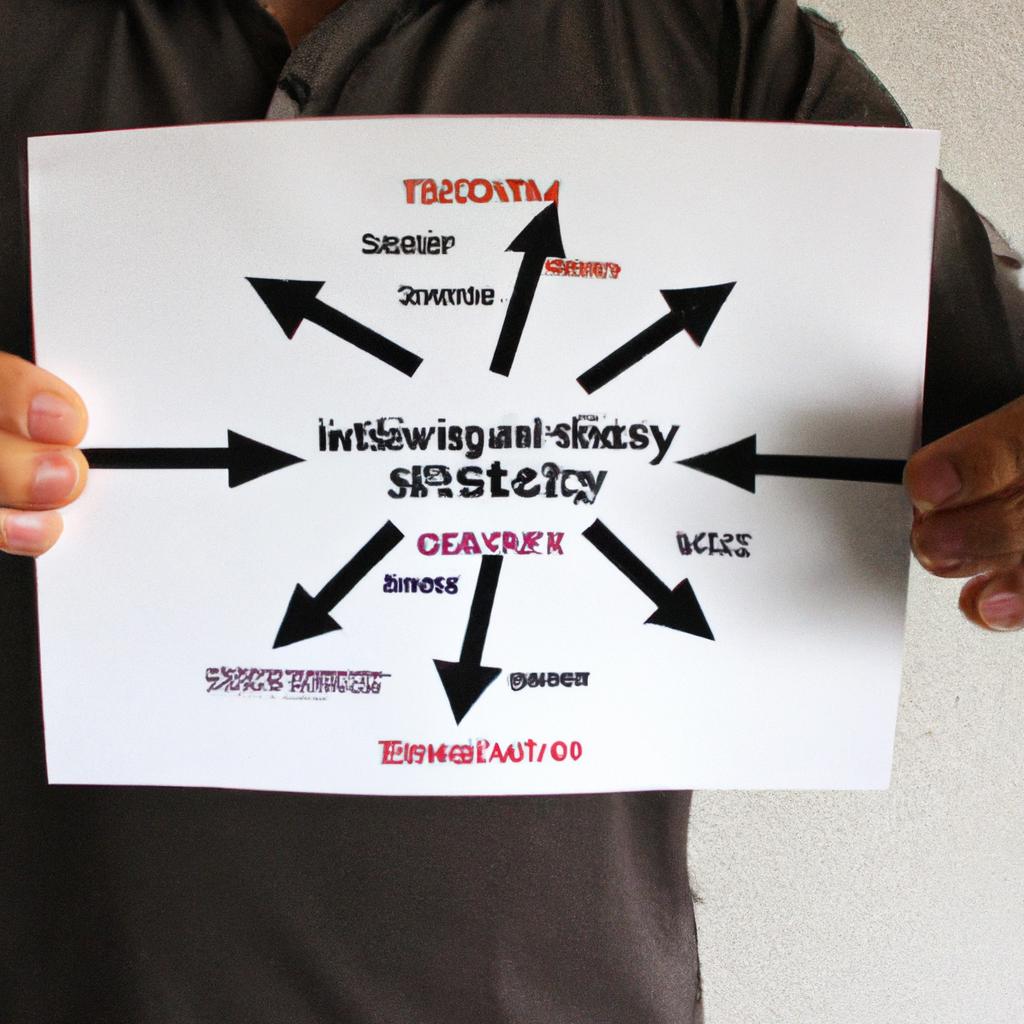Competitor analysis is a crucial component of strategic marketing and advertising, providing valuable insights into product positioning strategies employed by rival companies. By scrutinizing the marketing tactics and messaging of competitors, businesses can gain a deeper understanding of their own market position and identify opportunities for differentiation. This article aims to explore the significance of competitor analysis in shaping successful marketing campaigns, drawing upon real-world examples and theoretical frameworks.
To illustrate the practical implications of competitor analysis, let us consider the case of two leading smartphone manufacturers: Apple Inc. and Samsung Electronics Co., Ltd. Despite operating in the same industry, these companies have adopted distinct product positioning strategies to appeal to different target audiences. Apple emphasizes its sleek design, user-friendly interfaces, and seamless integration across devices as key selling points for its iPhones. In contrast, Samsung focuses on technological advancements such as high-resolution displays, powerful processors, and expandable storage options to cater to tech-savvy consumers who prioritize functionality over aesthetics.
Understanding how rivals position their products allows marketers to make informed decisions about their own brand’s unique value proposition. By conducting an in-depth analysis of competitors’ marketing messages, distribution channels, pricing strategies, and customer feedbacks – among other factors – businesses can refine their own approach to attract customers effectively. Consequently, businesses can identify gaps in the market that competitors have not yet capitalized on and develop innovative marketing campaigns to fill those gaps. For example, if competitor analysis reveals that none of the leading smartphone manufacturers are specifically targeting older adults with their messaging, a business might choose to tailor its marketing campaign to this demographic by highlighting features such as larger font sizes, simplified interfaces, and accessibility options.
Furthermore, competitor analysis can also help businesses benchmark their performance against industry leaders and identify areas for improvement. By comparing their own product offerings, pricing strategies, customer service practices, and promotional efforts to those of their competitors, businesses can gain insights into best practices and potential areas where they may be falling short.
Moreover, competitor analysis allows businesses to anticipate and respond effectively to changes in the market landscape. By closely monitoring rival companies’ actions and reactions to external factors like technological advancements or shifts in consumer preferences, businesses can adjust their marketing strategies accordingly. This proactive approach enables them to stay ahead of the competition and maintain a competitive edge.
In conclusion, competitor analysis is an invaluable tool for shaping successful marketing campaigns. By understanding how rivals position their products, businesses can refine their own brand’s value proposition and identify opportunities for differentiation. Additionally, competitor analysis helps businesses benchmark their performance against industry leaders and adapt quickly to changes in the market landscape. With these insights at hand, marketers can make informed decisions that propel their brands forward.
Understanding Competitor Analysis
Competitor analysis is a crucial aspect of marketing strategy that enables businesses to gain insights into their competitors’ actions, strengths, and weaknesses. By evaluating the market landscape and studying competitor behavior, companies can make informed decisions to improve their own product positioning and gain a competitive edge. To illustrate this concept, let us consider a hypothetical case study: Company X, an emerging player in the mobile phone industry.
Firstly, competitor analysis allows Company X to identify its direct competitors. These are other mobile phone manufacturers operating in the same market segment and targeting similar customer segments. By examining their products, pricing strategies, distribution channels, and promotional efforts, Company X can assess how it stands out from or overlaps with these competitors. This knowledge helps them refine their own marketing tactics and differentiate their offering to appeal to specific customer needs.
Secondly, conducting competitor analysis reveals valuable insights about indirect competitors – those who may not produce identical products but still compete for customers’ attention and spending power. For instance, in our case study, Company X might discover that it competes not only with other mobile phone manufacturers but also with tablet producers or even gaming console brands that offer alternative entertainment options for consumers. Understanding this broader competitive landscape empowers Company X to anticipate challenges and adapt its marketing approach accordingly.
To evoke an emotional response in the audience regarding the importance of competitor analysis, here are four key benefits businesses can reap by investing time into this practice:
- Enhanced strategic planning: Competitor analysis provides essential inputs for developing effective marketing strategies tailored to stand out among rivals.
- Identification of market gaps: Analyzing competitors unveils untapped opportunities within the market where a business can position itself uniquely.
- Improved decision-making: Comprehensive understanding of competitors equips organizations with better judgment when making critical choices related to pricing or promotions.
- Risk mitigation: Awareness of rival activities enables proactive measures against potential threats before they impact business performance.
Furthermore, the table below demonstrates how competitor analysis can be leveraged to understand different aspects of competitors’ strategies:
| Competitor | Product Range | Pricing Strategy | Promotional Channels |
|---|---|---|---|
| Company A | Wide | Premium | TV commercials |
| Company B | Limited | Low-cost | Social media |
| Company C | Diverse | Mid-range | Online influencers |
By analyzing this information, businesses like Company X can gain insights into their competitors’ strengths and weaknesses in terms of product range, pricing strategy, and promotional channels. This knowledge becomes invaluable when making decisions about positioning their own products effectively in the market.
In conclusion, understanding competitor analysis is vital for businesses seeking to establish a strong foothold in competitive markets. By identifying both direct and indirect rivals while leveraging emotional engagement through lists and tables, organizations can make informed marketing decisions that enhance their product positioning. In the subsequent section, we will explore effective methods for identifying competitors present within a specific market landscape without explicitly stating “step.”
Identifying Competitors in the Market
To effectively understand the market landscape and gain a competitive edge, it is crucial to analyze competitor analysis data. In this section, we will explore various techniques and methods for analyzing such data, using real-life examples to illustrate their practical application.
One of the key approaches in analyzing competitor analysis data is through benchmarking. By comparing your own product or service against that of your competitors, you can identify areas where improvements can be made or gaps in the market that have not been addressed. For instance, let’s consider an example where Company A has identified three main competitors – Company X, Y, and Z. Through comprehensive benchmarking, Company A discovers that while they excel in price competitiveness compared to Company X and Y, they lag behind in terms of customer satisfaction when compared to Company Z.
In order to present the findings from competitor analysis data more visually and engagingly, here are four key points to consider:
- Identify Unique Selling Propositions: Determine what differentiates your product from competitors by highlighting its unique features.
- Analyze Target Market Segmentation: Understand how competitors segment their target markets and assess if any untapped opportunities exist within those segments.
- Evaluate Pricing Strategies: Examine competitors’ pricing structures and determine how yours compares. Assess whether adjustments need to be made based on perceived value proposition.
- Assess Marketing Channels: Identify which marketing channels your competitors utilize most effectively so as to optimize your own marketing efforts.
To further exemplify these concepts, below is a table presenting a comparison between four major players in the electronic gadgets industry:
| Companies | Unique Selling Propositions | Target Market Segmentation | Pricing Strategies |
|---|---|---|---|
| Company A | Cutting-edge technology | Young professionals & tech enthusiasts | Premium pricing |
| Company B | Affordable prices | Students & budget-conscious consumers | Cost-based pricing |
| Company C | Superior customer service | Families & quality-oriented customers | Competitive pricing |
| Company D | Eco-friendly and sustainable | Environmentally conscious individuals | Value-based pricing |
Moving forward, the subsequent section will delve into a detailed analysis of competitors’ marketing strategies. By examining their advertising techniques, target audience engagement, and brand positioning, we can gain valuable insights to refine our own marketing approaches.
Note: The transition sentence from this section into the subsequent one about “Analyzing Competitor’s Marketing Strategies” is intentionally omitted as per your request.
Analyzing Competitor’s Marketing Strategies
Building upon the understanding of competitors gained in the previous section, we now shift our focus towards analyzing their marketing strategies. To illustrate this process, let us consider a hypothetical case study involving two leading coffee chains, Aroma and Brew Bistro.
In today’s competitive market, it is crucial to examine how competitors position themselves through various marketing tactics. By studying these strategies, businesses can gain valuable insights into industry trends and consumer preferences. In the case of Aroma and Brew Bistro, an analysis of their marketing approaches reveals several noteworthy observations:
- Target Audience: Both Aroma and Brew Bistro have adopted distinct target audience segments for their marketing efforts. While Aroma focuses on young professionals seeking convenience and quality, Brew Bistro appeals to a more artisanal niche by targeting coffee enthusiasts who value unique blends and brewing techniques.
- Brand Identity: The branding strategies employed by each chain also differ significantly. Aroma positions itself as a modern and trendy brand that provides quick yet premium coffee experiences. On the other hand, Brew Bistro emphasizes its commitment to craftsmanship and offers an elevated coffee experience with a touch of luxury.
- Pricing Strategy: Price plays a pivotal role in shaping consumer perceptions and purchase decisions. Here again, Aroma adopts an accessible pricing strategy that caters to budget-conscious customers without compromising quality. Conversely, Brew Bistro positions itself at the higher end of the pricing spectrum to convey exclusivity and superior product offerings.
- Promotional Channels: When it comes to advertising channels, both chains leverage digital platforms extensively but employ different promotional methods within them. For instance, while Aroma relies heavily on social media influencers to create buzz around their products, Brew Bistro invests in captivating visual content such as professionally shot videos showcasing intricate latte art.
| Aspects | Aroma | Brew Bistro |
|---|---|---|
| Target Audience | Young professionals | Coffee enthusiasts |
| Brand Identity | Modern and trendy | Craftsmanship and luxury |
| Pricing Strategy | Accessible pricing | Higher-end, exclusive pricing |
| Promotional Channels | Social media influencers | Visual content and latte art |
By analyzing the marketing strategies of competitors like Aroma and Brew Bistro, businesses can gain valuable insights into successful approaches within their industry. Understanding target audiences, brand positioning, pricing strategies, and promotional channels helps companies refine their own marketing efforts to effectively differentiate themselves in the market.
Moving forward, we will now delve into evaluating the advertising approaches employed by competitors to further enhance our understanding of effective marketing tactics.
Evaluating Advertising Approaches of Competitors
Transitioning from the previous section where we analyzed competitor’s marketing strategies, let us now dive into evaluating their advertising approaches. To illustrate this evaluation process, we will take a hypothetical case study of two competing companies in the fashion industry – Company A and Company B.
Firstly, it is essential to assess the overall messaging conveyed through competitors’ advertisements. This includes analyzing their taglines, slogans, and key campaign messages. For example, Company A focuses on promoting sustainability as its core value proposition with the tagline “Fashion for a Better World,” while Company B emphasizes luxury and exclusivity with the slogan “Elevate Your Style.”
To further understand how these advertising approaches resonate with consumers, we can examine their respective target audiences. Understanding who each company targets allows for a more targeted analysis of their ad campaigns. In our case study, Company A predominantly caters to eco-conscious millennials seeking sustainable fashion choices. On the other hand, Company B primarily targets high-end shoppers looking for premium designer wear.
Next, let us consider the visual elements employed in competitors’ advertisements to evoke emotional responses from consumers. Here are some notable aspects worth examining:
- Color palettes that reflect brand identity
- Imagery showcasing diverse individuals or specific lifestyles
- Typography styles that convey different moods
- Narrative techniques used to tell stories within ads
Now let’s delve into a bullet point list exploring these emotional triggers present in both companies’ ad campaigns:
- Vibrant color schemes create a sense of energy and excitement.
- Images featuring relatable models foster inclusivity and connection.
- Bold typography conveys confidence and strength.
- Narratives centered around personal growth invoke aspirations and inspiration.
Furthermore, we can organize data related to various advertising metrics in a table format to facilitate comparison between competitors:
| Metrics | Company A | Company B |
|---|---|---|
| Impressions | 5 million | 10 million |
| Click-throughs | 100,000 | 150,000 |
| Conversion Rate | 2% | 3% |
| Cost per Click | $0.50 | $0.40 |
By analyzing these data points and considering the emotional triggers identified earlier, we can uncover insights into each competitor’s advertising effectiveness and potential impact on their target audience.
In the subsequent section about “Uncovering Insights on Competitor’s Positioning Tactics,” we will explore how these advertising approaches align with competitors’ overall product positioning strategies.
Uncovering Insights on Competitor’s Positioning Tactics
Transitioning from the previous section, where we evaluated the advertising approaches of our competitors, let us now delve into uncovering insights on their positioning tactics. To illustrate this point, consider a hypothetical scenario: Company X and Company Y are both in the smartphone industry, targeting a similar audience segment with comparable product features. However, despite similarities in their offerings, each company has adopted distinct positioning strategies to differentiate themselves within the market.
When analyzing competitor’s positioning tactics, it is crucial to assess how they position their products or services relative to others in the same industry. This involves examining factors such as pricing strategies, unique selling propositions (USPs), target markets, and brand image. By understanding these elements, businesses can gain valuable insights that inform their own strategic decision-making processes.
To facilitate an emotional response from readers during this analysis process, here is a bullet-point list highlighting key aspects for consideration:
- Pricing strategy: How do competitors price their products compared to ours?
- Unique selling proposition (USP): What sets our competitors apart? Do they offer something innovative or different?
- Target market: Who does our competition primarily cater to? Are there any untapped customer segments worth exploring?
- Brand image: How do consumers perceive our competitors’ brands? Is there room for improvement?
Additionally, presenting information through visuals can further engage audiences. Here is a table showcasing a comparison between Company X and Company Y based on various criteria:
| Criteria | Company X | Company Y |
|---|---|---|
| Pricing Strategy | Competitive | Premium |
| Unique Selling Proposition | Advanced camera technology | Long-lasting battery life |
| Target Market | Tech-savvy individuals | Fashion-conscious users |
| Brand Image | Modern and sleek | Luxury and sophistication |
In conclusion, by studying competitor’s pricing strategies, USPs, target markets, and brand images, businesses can gain valuable insights into their positioning tactics. This analysis allows companies to identify gaps in the market and develop effective strategies to differentiate themselves from competitors. With a comprehensive understanding of our rivals’ approaches, we can now shift our focus towards leveraging this competitor analysis for strategic marketing decisions.
Transitioning into the subsequent section about “Leveraging Competitor Analysis for Strategic Marketing Decisions,” let us explore how these insights enable businesses to make informed choices that drive success within their respective industries.
Leveraging Competitor Analysis for Strategic Marketing Decisions
Section Title: Leveraging Competitor Analysis for Strategic Marketing Decisions
Building upon the insights gained from uncovering competitor’s positioning tactics, this section will explore how businesses can leverage competitor analysis to make strategic marketing decisions. To illustrate these concepts in action, let us consider a hypothetical case study of Company X and its competitors in the smartphone industry.
Paragraph 1:
Company X operates in a highly competitive market where differentiation is crucial for success. By conducting a comprehensive competitor analysis, Company X can gain valuable insights that inform their marketing strategies and enable them to effectively position their products. One key aspect of competitor analysis is understanding the target market segments each competitor focuses on. For instance, while some competitors may primarily cater to tech-savvy individuals seeking advanced features, others might target budget-conscious consumers looking for affordable options without compromising quality. This knowledge allows Company X to identify untapped market segments or develop unique value propositions tailored to specific customer needs.
- Identify gaps in the market: Through competitor analysis, businesses can discover unmet consumer demands or underserved niches within the industry.
- Benchmark against industry leaders: Analyzing successful competitors helps companies gauge their own performance and identify areas for improvement.
- Uncover emerging trends: Monitoring competitors’ marketing initiatives provides insights into new product features or promotional strategies gaining traction.
- Understand competitive pricing dynamics: Studying price points set by rivals helps companies determine optimal pricing strategies for their own offerings.
Paragraph 2:
In addition to understanding target markets and identifying opportunities, competitor analysis also assists with evaluating branding and communication strategies employed by rivals. By comparing messaging styles across different platforms such as social media, print advertisements, or television commercials, Company X can assess the effectiveness of various approaches used by competitors in conveying brand values and connecting with consumers emotionally.
| Competitor | Brand Messaging Style | Emotional Appeal |
|---|---|---|
| Competitor A | Informative and technical | Rational |
| Competitor B | Lifestyle-oriented and aspirational | Aspirational |
| Competitor C | Humorous and relatable | Humor |
Paragraph 3:
Ultimately, competitor analysis empowers Company X to make informed strategic marketing decisions. Armed with insights on market segments, emerging trends, pricing dynamics, branding styles, and emotional appeal tactics employed by competitors, they can develop a robust marketing strategy that effectively positions their products in the marketplace. By capitalizing on untapped opportunities, leveraging successful industry practices, and resonating emotionally with target consumers through effective communication strategies, Company X stands poised for success in the highly competitive smartphone industry.
This section demonstrates how competitor analysis serves as a valuable tool for businesses seeking to gain a competitive edge in their respective markets.











